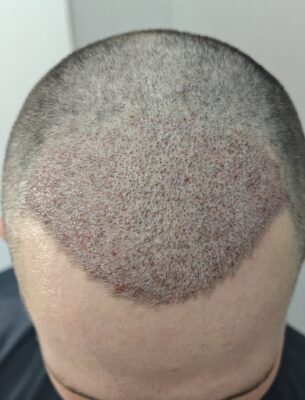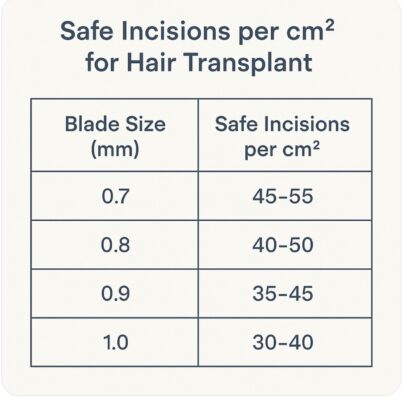The safe number of recipient incisions per square centimeter (cm²) in hair transplant surgery depends on:
1. Blade size (mm) this will depend on the size of follicular units, size of implanters which have 0.7, 0.8, 0.9, 1.0 mm
2. Spacing between incisions (to preserve vascularity and avoid compression necrosis)
Assumptions for Safe Density Calculation:
We’ll calculate maximum safe density assuming:
Incisions are rectangular and packed optimally.
A safe spacing is kept (minimum 0.3–0.4 mm between sites).
Density of 35–50 grafts/cm² is considered safe in most cases.
We’ll show theoretical maximums and practical safe values.
📊 Approximate Safe Incision Counts by Blade Size:
Blade Size Theoretical max Safe Practical
0.7 mm ~80–85/cm² 45–55/cm²
0.8 mm ~70–75/cm² 40–50/cm²
0.9 mm ~60–65/cm² 35–45/cm²
1.0 mm ~50–55/cm² 30–40/cm²
Tight packing assumes minimal spacing; not always advisable.
** Safe values to avoid poor vascular perfusion, especially in dense packing or high Norwood grades.
🧠 Rule of Thumb:
If blade size increases, the number of incisions per cm² decreases due to increased tissue trauma and vascular compromise.
🩺 Clinical Tip:
In most cases:
0.7 mm: ideal for single-hair grafts in the first 2-3 rows of frontal hairline.
0.8-0.9 mm: ideal for 2-hair grafts in the frontal hairline.
0.9–1.0 mm: better suited for 3-hair grafts in most inner area in hairline or forelock, center of mid scalp.



